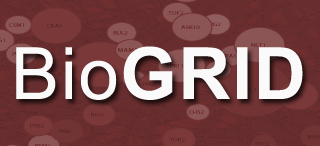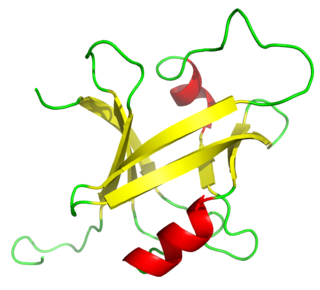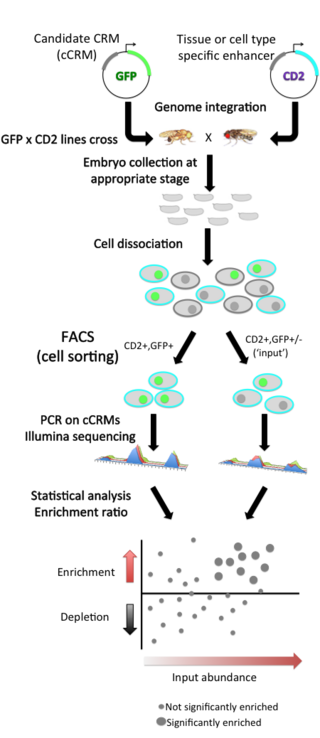Related Research Articles

Drosophila melanogaster is a species of fly in the family Drosophilidae. The species is often referred to as the fruit fly or lesser fruit fly, or less commonly the "vinegar fly", "pomace fly", or "banana fly". Starting with Charles W. Woodworth's 1901 proposal of the use of this species as a model organism, D. melanogaster continues to be widely used for biological research in genetics, physiology, microbial pathogenesis, and life history evolution. As of 2017, six Nobel Prizes have been awarded to drosophilists for their work using the insect.

DNA-binding proteins are proteins that have DNA-binding domains and thus have a specific or general affinity for single- or double-stranded DNA. Sequence-specific DNA-binding proteins generally interact with the major groove of B-DNA, because it exposes more functional groups that identify a base pair.

Pfam is a database of protein families that includes their annotations and multiple sequence alignments generated using hidden Markov models. The most recent version, Pfam 35.0, was released in November 2021 and contains 19,632 families.

KEGG is a collection of databases dealing with genomes, biological pathways, diseases, drugs, and chemical substances. KEGG is utilized for bioinformatics research and education, including data analysis in genomics, metagenomics, metabolomics and other omics studies, modeling and simulation in systems biology, and translational research in drug development.

The Biological General Repository for Interaction Datasets (BioGRID) is a curated biological database of protein-protein interactions, genetic interactions, chemical interactions, and post-translational modifications created in 2003 (originally referred to as simply the General Repository for Interaction Datasets by Mike Tyers, Bobby-Joe Breitkreutz, and Chris Stark at the Lunenfeld-Tanenbaum Research Institute at Mount Sinai Hospital. It strives to provide a comprehensive curated resource for all major model organism species while attempting to remove redundancy to create a single mapping of data. Users of The BioGRID can search for their protein, chemical or publication of interest and retrieve annotation, as well as curated data as reported, by the primary literature and compiled by in house large-scale curation efforts. The BioGRID is hosted in Toronto, Ontario, Canada and Dallas, Texas, United States and is partnered with the Saccharomyces Genome Database, FlyBase, WormBase, PomBase, and the Alliance of Genome Resources. The BioGRID is funded by the NIH and CIHR. BioGRID is an observer member of the International Molecular Exchange Consortium.
The Open Regulatory Annotation Database is designed to promote community-based curation of regulatory information. Specifically, the database contains information about regulatory regions, transcription factor binding sites, regulatory variants, and haplotypes.
FlyBase is an online bioinformatics database and the primary repository of genetic and molecular data for the insect family Drosophilidae. For the most extensively studied species and model organism, Drosophila melanogaster, a wide range of data are presented in different formats.

In molecular biology, heat shock factors (HSF), are the transcription factors that regulate the expression of the heat shock proteins. A typical example is the heat shock factor of Drosophila melanogaster.

CCAAT/enhancer-binding protein gamma (C/EBPγ) is a protein that in humans is encoded by the CEBPG gene. This gene has no introns.

Teashirt homolog 3 is a protein that in humans is encoded by the TSHZ3 gene. In mice, it is a necessary part of the neural circuitry that controls breathing. The gene is also a homolog of the Drosophila melanogaster teashirt gene, which encodes a zinc finger transcription factor important for development of the trunk.

The B3 DNA binding domain (DBD) is a highly conserved domain found exclusively in transcription factors combined with other domains. It consists of 100-120 residues, includes seven beta strands and two alpha helices that form a DNA-binding pseudobarrel protein fold ; it interacts with the major groove of DNA.

In molecular biology, STRING is a biological database and web resource of known and predicted protein–protein interactions.
PDBsum is a database that provides an overview of the contents of each 3D macromolecular structure deposited in the Protein Data Bank. The original version of the database was developed around 1995 by Roman Laskowski and collaborators at University College London. As of 2014, PDBsum is maintained by Laskowski and collaborators in the laboratory of Janet Thornton at the European Bioinformatics Institute (EBI).
In molecular biology, the BEN domain is a protein domain which is found in diverse proteins including:
TRANSFAC is a manually curated database of eukaryotic transcription factors, their genomic binding sites and DNA binding profiles. The contents of the database can be used to predict potential transcription factor binding sites.

Enhancer-FACS-seq (eFS), developed by the Bulyk lab at Brigham and Women’s Hospital and Harvard Medical School, is a highly parallel enhancer assay that aims for the identification of active, tissue-specific transcriptional enhancers, in the context of whole Drosophila melanogaster embryos. This technology replaces the use of microscopy to screen for tissue-specific enhancers with fluorescence activated cell sorting (FACS) of dissociated cells from whole embryos, combined with identification by high-throughput Illumina sequencing.

Sarah Amalia Teichmann is a German scientist who is head of cellular genetics at the Wellcome Sanger Institute and a visiting research group leader at the European Bioinformatics Institute (EMBL-EBI). She serves as director of research in the Cavendish Laboratory, at the University of Cambridge and a senior research fellow at Churchill College, Cambridge.
Proboscipedia (pb) is a protein coding gene in Drosophila melanogaster.
Transcription factors are proteins that bind genomic regulatory sites. Identification of genomic regulatory elements is essential for understanding the dynamics of developmental, physiological and pathological processes. Recent advances in chromatin immunoprecipitation followed by sequencing (ChIP-seq) have provided powerful ways to identify genome-wide profiling of DNA-binding proteins and histone modifications. The application of ChIP-seq methods has reliably discovered transcription factor binding sites and histone modification sites.
References
- ↑ "DroID - The Drosophila Interactions Database" . Retrieved 10 July 2019.
- ↑ Yu, Jingkai; Pacifico, Svetlana; Liu, Guozhen; Finley Jr, Russell L. (2008). "DroID: The Drosophila Interactions Database, a comprehensive resource for annotated gene and protein interactions". BMC Genomics. 9: 461. doi: 10.1186/1471-2164-9-461 . PMC 2572628 . PMID 18840285.
- ↑ "About Us". DroID. Retrieved 10 July 2019.
- ↑ St. Pierre, Susan; McQuilton, Peter (2009). "Inside Fly Base: Biocuration as a career". Fly. 3 (1): 112–114. doi:10.4161/fly.3.1.7769. PMC 2837272 . PMID 19182544.
- 1 2 Thurmond, Jim; Goodman, Joshua L.; Strelets, Victor B.; Attrill, Helen; Gramates, L Sian; Marygold, Steven J.; Matthews, Beverley B.; Millburn, Gillian; Antonazzo, Giulia; Trovisco, Vitor; Kaufman, Thomas C.; Calvi, Brian R.; Perrimon, Norbert; Gelbart, Susan Russo; Agapite, Julie; Broll, Kris; Crosby, Lynn; Santos, Gilberto dos; Emmert, David; Gramates, L. Sian; Falls, Kathleen; Jenkins, Victoria; Matthews, Beverley; Sutherland, Carol; Tabone, Christopher; Zhou, Pinglei; Zytkovicz, Mark; Brown, Nick; Antonazzo, Giulia; et al. (2019). "Fly Base 2.0: The next generation". Nucleic Acids Research. 47 (D1): D759–D765. doi:10.1093/nar/gky1003. PMC 6323960 . PMID 30364959.
- ↑ "FlyBase:About" . Retrieved 10 July 2019.
- ↑ Zhu, Lihua Julie; Christensen Ryan G; Kazemian Majid; Hull Christopher J; Enuameh Metewo Selase; Basciotta Matthew D; Brasefield Jessie A; Zhu Cong; Asriyan Yuna; Lapointe David S; Sinha Saurabh; Wolfe Scot A; Brodsky Michael H (Jan 2011). "FlyFactorSurvey: a database of Drosophila transcription factor binding specificities determined using the bacterial one-hybrid system". Nucleic Acids Res. England. 39 (Database issue): D111-7. doi:10.1093/nar/gkq858. PMC 3013762 . PMID 21097781.
- ↑ "FlyFactorSurvey Homepage". UMass. Retrieved 10 July 2019.
- ↑ "About FlyMine". 2014-11-17. Retrieved 10 July 2019.
- ↑ Lyne, Rachel; Smith, Richard; Rutherford, Kim; Wakeling, Matthew; Varley, Andrew; Guillier, Francois; Janssens, Hilde; Ji, Wenyan; McLaren, Peter; North, Philip; Rana, Debashis; Riley, Tom; Sullivan, Julie; Watkins, Xavier; Woodbridge, Mark; Lilley, Kathryn; Russell, Steve; Ashburner, Michael; Mizuguchi, Kenji; Micklem, Gos (2007). "Fly Mine: An integrated database for Drosophila and Anopheles genomics". Genome Biology. 8 (7): R129. doi: 10.1186/gb-2007-8-7-r129 . PMC 2323218 . PMID 17615057.
- ↑ "FlyMine" . Retrieved 10 July 2019.
- 1 2 Shazman, Shula; Lee, Hunjoong; Socol, Yakov; Mann, Richard S.; Honig, Barry (2014). "OnTheFly: A database of Drosophila melanogaster melanogastertranscription factors and their binding sites". Nucleic Acids Research. 42 (Database issue): D167–D171. doi:10.1093/nar/gkt1165. PMC 3965123 . PMID 24271386.
- ↑ "OnTheFly Homepage". Honig Lab. Retrieved 10 July 2019.
- ↑ Rivera, John; Keränen, Soile V E; Gallo, Steven M.; Halfon, Marc S. (2019). "REDfly: The transcriptional regulatory element database for Drosophila". Nucleic Acids Research. 47 (D1): D828–D834. doi:10.1093/nar/gky957. PMC 6323911 . PMID 30329093.
- ↑ "REDfly About Us". REDfly. Retrieved 10 July 2019.